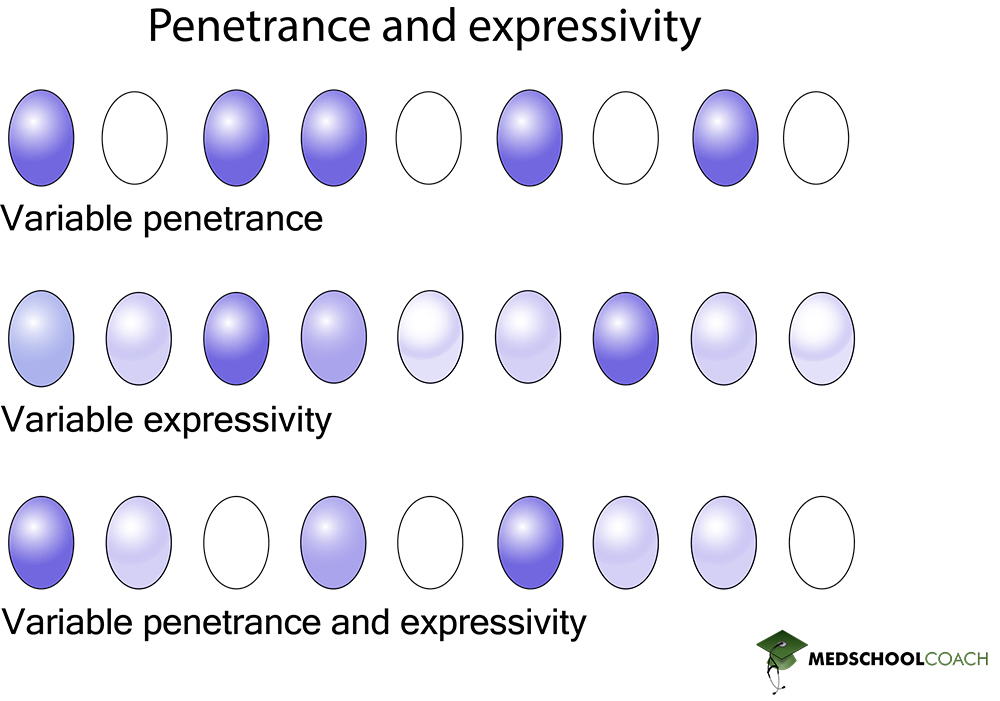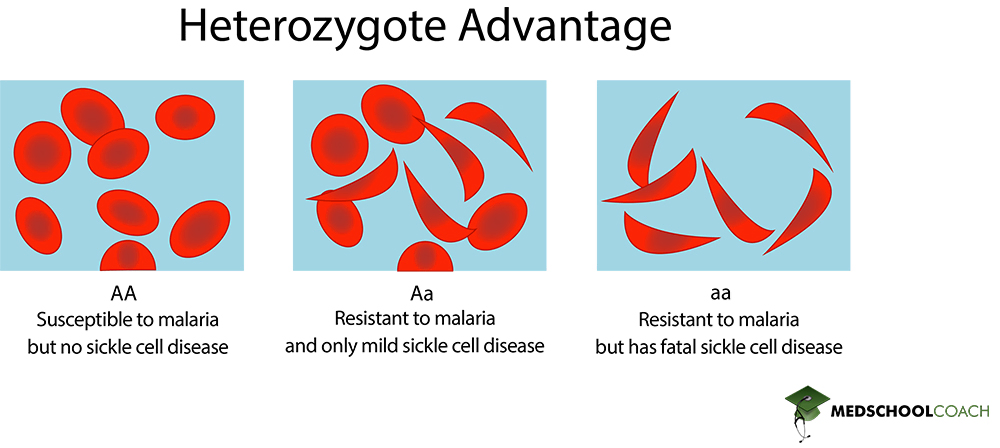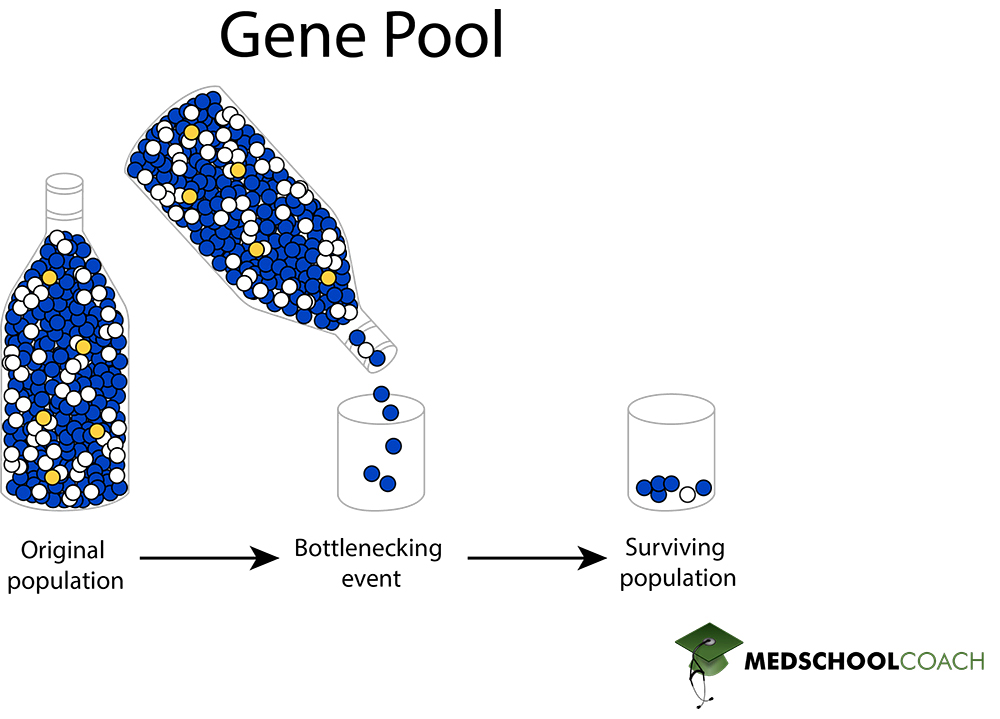Dominance, Penetrance, Expressivity, Hybrid Viability, and Gene Pool
MCAT Biology
- Home
- »
- MCAT Masterclass
- »
- Biological and Biochemical Foundations of Living Systems
- »
- Biology
- »
- Dominance, Penetrance, Expressivity, Hybrid Viability, and Gene Pool – MCAT Biology
Sample MCAT Question:
Which of the following is an example of expressivity?
b) Though 90% of individuals in a population have the allele for dwarfism, only 2% of individuals in the population phenotypically express dwarfism.
c) An individual has genes for both brown and blonde hair, but only phenotypically expresses brown hair.
d) Though 10 individuals share the gene for brown eyes, the shade of brown varies considerably from individual to individual.
Get 1-on-1 MCAT Tutoring From a Specialist
With MCAT tutoring from MedSchoolCoach, we are committed to help you prepare, excel, and optimize your ideal score on the MCAT exam.
For each student we work with, we learn about their learning style, content knowledge, and goals. We match them with the most suitable tutor and conduct online sessions that make them feel as if they are in the classroom. Each session is recorded, plus with access to whiteboard notes. We focus on high-yield topics if you’re pressed for time. If you have more time or high-score goals, we meticulously cover the entire MCAT syllabus.
Mendelian genetics is the study of biological inheritance first proposed by a Christian monk named Gregor Mendel in the nineteenth century. At first, Mendel’s theories were controversial, but soon, with more study, they became accepted into the scientific community. Several concepts derived from Mendelian genetics help explain the inheritance patterns of reproduction. These concepts include dominance, leakage, penetrance, expressivity, hybrid viability, and gene pools. All of these concepts are important to understand for the MCAT exam.
Dominance
There are three different types of dominance that are important to understand for the MCAT – complete dominance, incomplete dominance, and codominance. Figure 1 shows the difference between complete and incomplete dominance. In complete dominance, the dominant allele completely masks the effects of the recessive allele in heterozygotes. In Figure 1, the homozygous dominant plant with RR alleles has red flowers. The homozygous recessive plant with rr alleles has white flowers. Lastly, the heterozygote with Rr alleles once again has red flowers. Because flower color is controlled by complete dominance, the heterozygote has a phenotype entirely determined by the dominant allele, and the recessive alleleis masked.

However, in incomplete dominance, neither allele is dominant. In this way, the phenotype of the heterozygote is an intermediate of the two homozygous phenotypes. In Figure 1, the plant with the RR alleles has red flowers, the plant with the rr alleles has white flowers. The heterozygote, Rr, has pink flowers, a mixture of red and white. Pink is not the phenotype of either homozygous plant but is instead an intermediary of them.
The last type of dominance is codominance, in which both alleles are expressed. The typical example of codominance is human blood type (Figure 2). In terms of blood types, there are three different levels: the IA allele, the IB allele, and the i allele. Individuals who have the genotype ‘IA IA’ or ‘IA I’, have the A antigen on their red blood cells, and their blood type is A. Individuals with the genotype ‘IB IB’ or ‘IB I’, have the B antigen on their red blood cells and their blood type is B. Those who have the genotype ‘IA IB’, express both the A and B antigens on their red blood cells and their blood type is AB. The blood type of these individuals is an example of codominance because they express both alleles. Lastly, those with the genotype ‘i i’, do not express any antigens on their red blood cells, and their blood type is O.

Leakage
Leakage refers to the transfer of genes from one species to another. This concept is often discussed with regards to genetically modified organisms, or GMOs. For example, a particular crop could be genetically modified to have resistance to pesticides. In this way, farmers can grow these genetically modified crops and apply pesticides that will kill the weeds but spare the crops. If the pesticide resistance gene is transferred from crops to weeds, this represents leakage. Transference of this gene is a concern in the field of GMOs because if the weeds gain the pesticide resistance gene, they will be hard to get rid of, which poses a significant problem for farmers.
Penetrance and Expressivity
Penetrance is another concept important in Mendelian genetics. It refers to the percentage of organisms with a particular allele that have the associated phenotype. Organisms with a particular allele do not always have to express a particular phenotype. For example, 70% of mice with a mutation and the COL1A1 gene have bone fractures, which is the phenotype associated with this allele. In this way, since only 70% of mice with this allele have this phenotype, the COL1A1 mutation has a 70% penetrance.
Expressivity refers to the degree to which a trait is expressed in individuals. These are often traits that are not necessarily all or none, but rather on a spectrum of possible phenotypes. The concepts of penetrance and expressivity are summarized in Figure 3. Penetrance is visualized in the top row. Individuals with the allele either have the phenotype, or they do not. The percentage of individuals that express the phenotype due to that allele defines the penetrance. Expressivity is visualized in the second row. In this row, all individuals have the phenotype, but the degree to which they have the phenotype varies. In this way, the phenotype is stronger in some individuals and weaker and in others. The last row is a visualization of both penetrance and expressivity. In this row, some individuals have the phenotype, and others do not. The individuals with the phenotype can have a strong phenotypic expression or a weaker phenotypic expression.

Hybrid Viability
Another Mendelian concept is termed hybrid viability. Hybrid viability refers to the ability of heterozygotes to pass on their genes to the next generation of offspring. Two common concepts that are essential to understand in terms of hybrid viability are hybrid inviability and heterozygote advantage. Hybrid inviability refers to situations in which hybrids are unable to produce offspring. A typical example of hybrid inviability is mules. A mule is a hybrid that is produced from a cross between a donkey and a horse. While they are living animals that can move around, eat, and generally survive, they are sterile and cannot reproduce to form offspring.
Heterozygote advantage refers to situations in which heterozygotes have greater viability than homozygous dominant or homozygous recessive organisms. A common example of this concept is sickle cell anemia in Africa. In many African nations and several other nations throughout the world, malaria is a severe disease that causes numerous deaths. In sickle cell anemia, there is a mutation that causes red blood cells to change shape. The mutation affects a particular allele, so humans can have two wild-type alleles and have healthy red blood cells or have two mutant alleles and have red blood cells that have a sickle shape (Figure 4). In the third instance, individuals may be heterozygotes, and have one copy of the wild type allele and one copy of the mutant, sickle cell, allele. In this way, heterozygotes have both healthy red blood cells and sickle cell red blood cells.
In terms of malaria, humans with normal red blood cells are targets for mosquitos, and if they get malaria, they can die. Also, individuals with sickle cell anemia who get malaria can die. However, it turns out that heterozygotes are protected from malaria. They have half healthy red blood cells and half sickled red blood cells. Mosquitos do not affect sickled red blood cells as much as normal ones, so these individuals have some protection against malaria. Heterozygotes do not fully express sickle cell anemia and have some protection against anemia, so this is an example of heterozygote advantage.

Gene Pool
The last concept of Mendelian genetics that is important for the MCAT exam is the concept of a gene pool. The gene pool refers to all of the genes in a population. Measuring a gene pool is measuring biodiversity. The purpose of pooling all of the genes together is to measure how much variation exists in the population. A population that has many variations is said to have high genetic diversity, whereas a population with multiple copies of the same genes is one that has a low genetic diversity.
Furthermore, a gene pool can be altered in several ways. First, there is inbreeding. Inbreeding refers to when the same individuals within a population breed with each other repeatedly. The advantage of inbreeding is that it can persevere favorable traits in a population. However, the downside is that organisms have a limited number of traits available. In other words, inbreeding reduces the gene pool.
Another example of how the gene pool can be altered is through population bottlenecks (Figure 5). Population bottlenecks refer to catastrophic events in which a significant percentage of the population perishes or is lost to a natural disaster or fatal event. When these events occur, the remaining population, or the individuals that survived, are not necessarily representative of the original population. The alleles that the surviving population has after the event represent the gene pool of that population. The event itself may have led to a loss of several genes or alleles in the population. In this way, population genetics also reduces the diversity of the gene pool.

Explore More MCAT Masterclass Chapters
Take a closer look at our entire MCAT Masterclass or explore our Biochemistry lessons below.

One-on-One Tutoring
Are you ready to take your MCAT performance to a whole new level? Work with our 99th-percentile MCAT tutors to boost your score by 12 points or more!
See if MCAT Tutoring can help me
Talk to our enrollment team about MCAT Tutoring

MCAT Go Audio Course
Engaging audio learning to take your MCAT learning on the go, any time, any where. You'll be on the way to a higher MCAT score no matter where you are. Listen to over 200+ lessons.

MCAT Practice Exams
Practice makes perfect! Our mock exams coupled with thorough explanations and in-depth analytics help students understand exactly where they stand.

MCAT Prep App
Access hundreds of MCAT videos to help you study and raise your exam score. Augment your learning with expert-created flashcards and a question banks.
